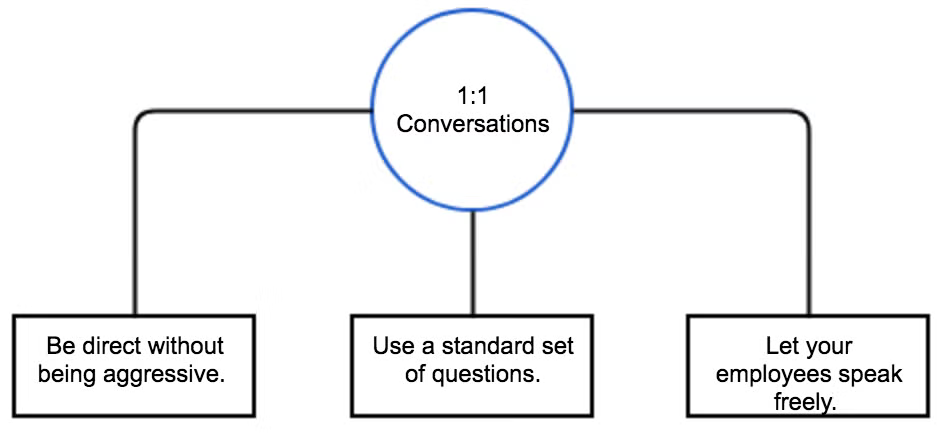Dreading Monday, peeling out early on a Friday afternoon, decreased initiative — all telltale signs of a disengaged worker, and none of it good. If you think that one of your employees is stepping off the gas, you can tear your hair out trying to figure out what's wrong, or how to bring up addressing the problem without sounding like you're about to fire them.

Yeah, Calvin is definitely disengaged from elementary school. |(Source)
How and when is it best to bring up disengagement? What are processes you can use to check in with employees about their enthusiasm for work before it's too late and they quit? Are your employees really going to feel comfortable talking about the less glamorous parts of their job with a boss or manager?
The truth is, it's always going to be uncomfortable for employees to talk about their lack of engagement, and it's always going to be tough to hear their points. But there is definitely a right way to do it, and improving engagement is critical for your business. It lowers employee churn, boosts productivity, and makes your workplace a better environment.
Start The Conversation By Checking In
Opening lines of communication with your employees about their job engagement takes a little effort. You need to lay out a couple of different ways to hear from employees on a regular basis. Even the most motivated employee will come up against a hurdle or two, and keeping a running dialogue will make it easier and easier to bring issues of engagement up.
In-Person Communication
You should set aside regular time for a regular face-to-face chat — at least once a quarter. It helps employees feel heard and gives you the chance to ask followup questions.
When you're talking with an employee 1:1 about engagement, it should be a structured conversation, not an informal chat. You should have a fairly standard set of questions and you should be prepared to sit back and let your employee speak their mind.
Be sure to preface the conversation with your clear intents: to help make the employee's experience better and troubleshoot problems at work — not to punish someone. This is critical, because it will help your employees speak freely and openly about their concerns and desires.

Group conversations are also important. They can be a great way to discuss common problems. But don't jump straight to an all-company or all-team meeting — take the time to digest information from individuals before you try to solve problems as a group, or you'll lack a clear direction in your group conversation.
Using Software Tools
While talking face-to-face is an excellent practice, there is also something to be said for using software tools to help gauge your employees' engagement.
For one thing, they can allow for anonymous submissions of feedback. This can be a great way to help get a bigger picture of your employee engagement, and look for common trends. It can also give you starting places to have 1:1 conversations because you have a better idea of the concerns that someone in a particular role might have.
A great way to solicit feedback is sending out a survey at a regular interval, says Bob Kelleher, CEO of The Employee Engagement Group. You can easily set one up with any number of dedicated tools, and might even be able to add an anonymous questionnaire using tools you already use, like Airtable. You can keep a standard set of questions or leave them the same until they aren't useful anymore.
A longer survey could be given once a month, you could have a standing open anonymous submission box, use a tool that helps employees rank their weeks and set goals, like 15five, or do a big quarterly breakdown.
Whatever you choose, stress that giving feedback through surveys is mandatory. If the tool is there, but nobody uses it, you're just wasting money on software. And if employees are really reticent to give feedback through surveys, check in with them — that could actually be a warning sign of disengagement and a lack of buy-in to their work.
Listening With Intention
Asking employees for feedback is hard, but it's only one part of the equation. The other part — and what's equally as difficult — is listening to your employees when they talk about why they may not be truly engaged.

Once again, Calvin helpfully demonstrates the exact opposite of what you should aim for. | (Source)
Here are some tips to hone your active listening skills:
- Ask open ended questions. Don't try too hard to steer the conversation or the answers you get.
- Don't lead with your opinion. Let your employee lay out their point of view before you offer your opinion — if you offer it in your first conversation at all.
- Engage while you listen. Let your body language be relaxed and open, and offer signs that you're listening, like nodding or passive agreements (alright, uh-huh, sure).
- Take notes. Keep jotting things down during the conversation — it will help you remember what you talked about and keep you focused on the employee.
- Put yourself in their shoes. It might be tempting to immediately chalk up an employee problem to them not trying hard, or some one-off failure in one project. Instead of jumping to conclusions, try to see the whole scenario from their perspective — not management's.
When you're actively listening, you're going to get more open, honest feedback from your team. It will also help disengaged employees feel like they're being heard and that someone wants to help them succeed. This in and of itself is a valuable tool for rekindling engagement.
Making The Right Changes
After you check in with your team, you have to put changes in action to actually bump your employee engagement. Start by going over your materials and separate personal problems from systemic problems.
For personal problems, solutions often don't need to be dramatic to be effective. They key here is to try to find the root of the problem and course correct. If an employee is dissatisfied with their work, shifting projects might help. If they feel like the hours are inflexible and keep them from family time, giving flex time can help them work better hours for their schedule. If they're miserable in sales but love your product and love a people-facing role, a shift to customer service might tick all their boxes.

Despite what Calvin's parents have espoused, your employees don't need to be miserable to build their character, or their careers. (Source)
For systemic problems, you might need to make more than a small change. Say your teams don't feel like they're getting good feedback, and are therefore frustrated and don't see a path for improvement. This problem might require you completely overhauling job criteria and performance reviews.
It might take some time and some manpower to set in action, but once you've decided to make that change, let your employees know. They'll be grateful that you're taking the time to create a thoughtful solution, and will likely be heartened by it, even before you finish putting it in place.
Rinse And Repeat
After you've made some changes, keep checking in on employee engagement. All employees will go through lows and highs at your company, and many will benefit from a little boost every now and again. With regular conversations about engagement, expectations and work enjoyment, you can nip problems in the bud. After all, you want your team members to feel empowered to succeed — not to feel like they just want to give up.

Employees should feel like superheroes, not super done with their job. |(Source)
The truth is that most people actually want to feel engaged at their jobs. They want to wake up in the morning and know they have something interesting to work on during the day. They want to leave the office feeling like they accomplished something or helped someone. And they'll work with you to make that happen. So check in, listen, and follow up. Your business will thank you.